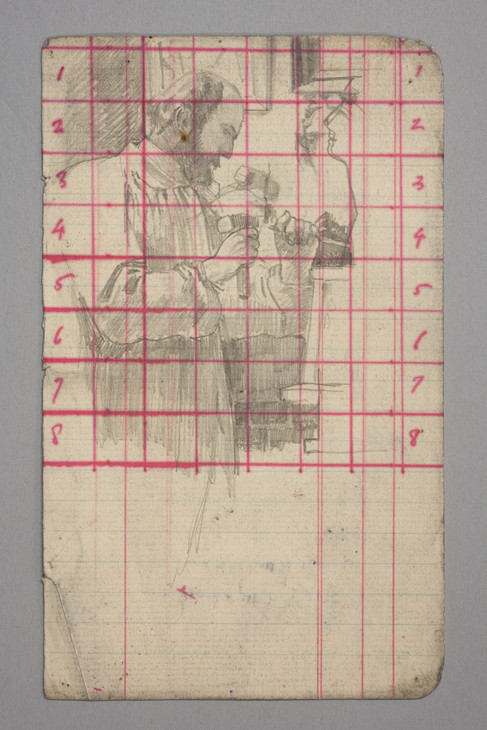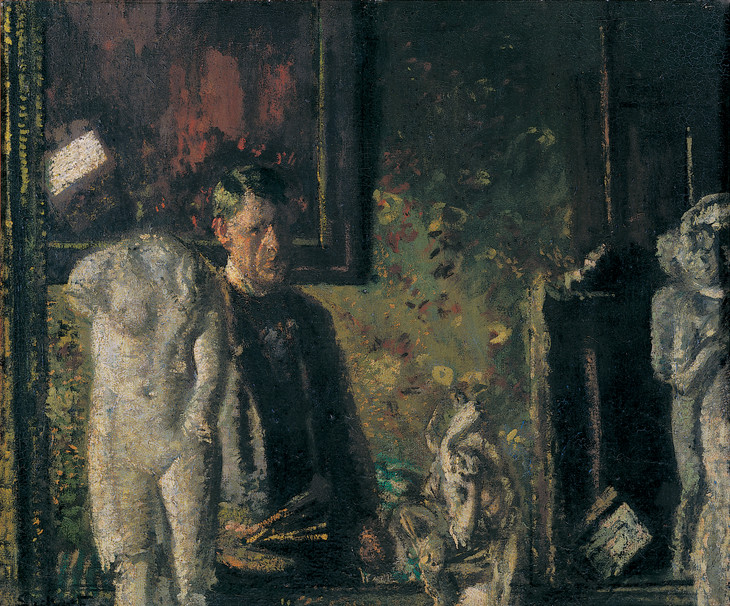Malcolm Drummond Study for 'The Sculptor's Studio' c.1910

Malcolm Drummond 1880–1945
Study for 'The Sculptor's Studio' c.1910
Graphite and red ink on account book paper
Inscribed by the artist with numbers 1-8 in red ink on left and right
Tate Archive TGA 8915
Purchased from Joyce Mills, September 1989
© Estate of Malcolm Drummond
Malcolm Drummond 1880–1945
Study for 'The Sculptor's Studio' c.1910
Graphite and red ink on account book paper
Inscribed by the artist with numbers 1-8 in red ink on left and right
Tate Archive TGA 8915
Purchased from Joyce Mills, September 1989
© Estate of Malcolm Drummond
This squared-up drawing is a study for the painting The Sculptor’s Studio c.1910 (Waterman Fine Art, London, reproduced in Wendy Baron, The Camden Town Group, London 1979, pl.63). Drummond exhibited work for the first time, including this painting, at the Allied Artists’ Association in 1910. The organiser of the exhibition, Frank Rutter, wrote in the Sunday Times that Drummond’s ‘grasp of form and keen sense of colour are best displayed in his “Sculptor’s Studio” ... a painting to be raved about a few years hence if his name becomes widely known’ (17 July 1910).

Walter Richard Sickert 1860–1942
Self-Portrait: The Painter in his Studio 1907
Oil paint on canvas
508 x 610 mm
Art Gallery of Hamilton, Ontario. Gift of the Women’s Committee, 1970
© Estate of Walter R. Sickert / DACS
Photo © Art Gallery of Hamilton, Ontario
Fig.1
Walter Richard Sickert
Self-Portrait: The Painter in his Studio 1907
Art Gallery of Hamilton, Ontario. Gift of the Women’s Committee, 1970
© Estate of Walter R. Sickert / DACS
Photo © Art Gallery of Hamilton, Ontario
Both study and painting depict Mervyn Lawrence (1868–1961), an Irish sculptor who exhibited alongside Camden Town Group members, including Drummond, at the Exhibition of the Work of English Post-Impressionists, Cubists and Others at Brighton Public Art Galleries, December 1913 – January 1914. He became a life class teacher at the Westminster School of Art alongside Sickert in c.1916 and was later made deputy headmaster under Walter Bayes. From 1921 to 1931 Drummond also taught classes at the institution. Both Drummond and Lawrence lived in the Kensington and Chelsea area around the period when The Sculptor’s Studio was painted.
The details of the study and the finished painting differ. The drawing presents a close-up of Lawrence in profile sculpting what appears to be a female bust (possibly the one in the background of the painting). The painting, on the other hand, shows more of the surrounding studio and depicts Lawrence at a three-quarter angle sculpting a nude. There are further studies related to the painting in the Tate Archive (TGA 8915).
Wendy Baron, The Camden Town Group, London 1979, pp.28, 158, 196.
Wendy Baron, Perfect Moderns: A History of the Camden Town Group, Aldershot and Vermont 2000, pp.40, 81 n.90.
‘Mervyn Lawrence’, Mapping the Practice and Profession of Sculpture in Britain and Ireland 1851–1951, University of Glasgow History of Art and HATII, online database 2011, http://sculpture.gla.ac.uk/view/person.php?id=msib2_1203019160 , accessed 2 June 2011.
Wendy Baron, Perfect Moderns: A History of the Camden Town Group, Aldershot and Vermont 2000, pp.40, 81 n.90.
‘Mervyn Lawrence’, Mapping the Practice and Profession of Sculpture in Britain and Ireland 1851–1951, University of Glasgow History of Art and HATII, online database 2011, http://sculpture
How to cite
Malcolm Drummond, Study for 'The Sculptor's Studio', c.1910, in Helena Bonett, Ysanne Holt, Jennifer Mundy (eds.), The Camden Town Group in Context, Tate Research Publication, May 2012, https://www
